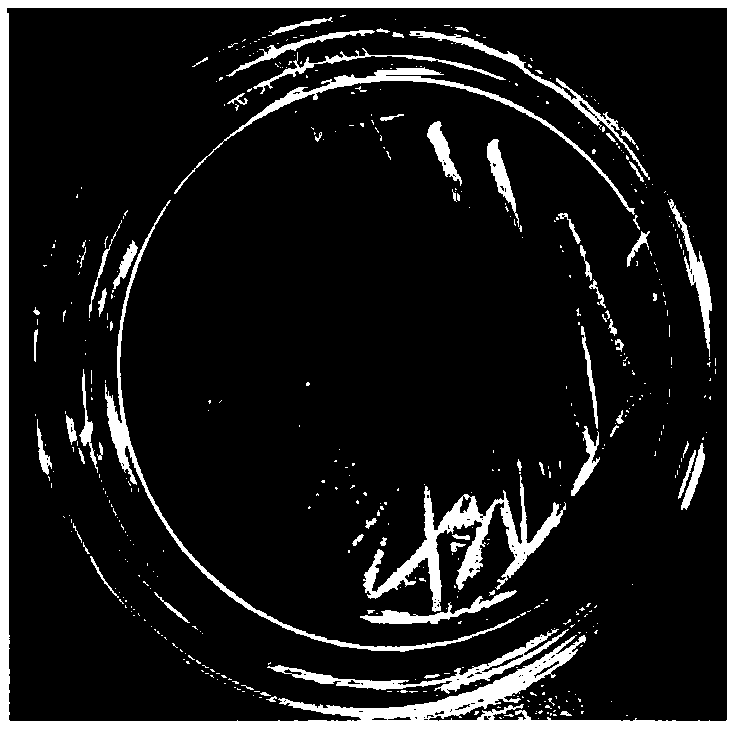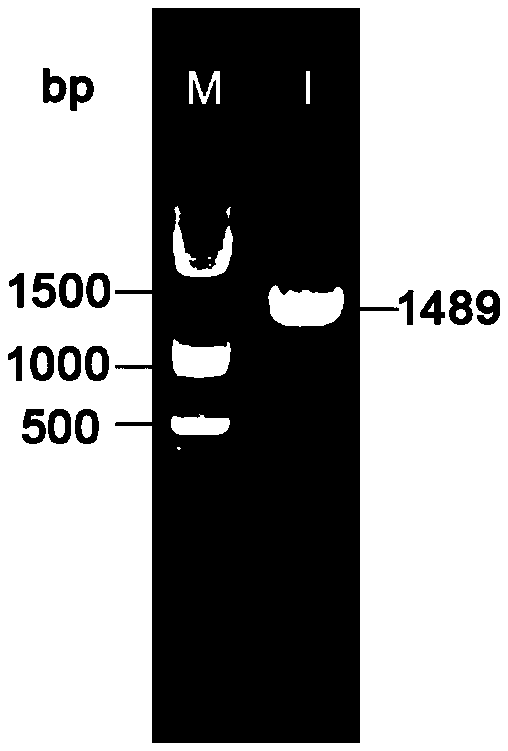Strain for producing low-temperature sterol esterase and fermentation method thereof
A technology of sterol esterase and fermentation method, which is applied in the field of obtaining sterol esterase by fermentation of low-temperature strains, and achieves the effects of satisfying industrial production needs, wide application value and reducing production cost.
- Summary
- Abstract
- Description
- Claims
- Application Information
AI Technical Summary
Problems solved by technology
Method used
Image
Examples
Embodiment 1
[0038] The acquisition of low-temperature sterol esterase-producing bacteria Q-06:
[0039] 1) Original strain Pseudomonas fragi (CGMCC NO.1.3349) activation: activation medium: tryptone 8.0~10.0 g, yeast powder 4.0 g~9.0 g, NaCl 8.0~10.0 g, agar 18.0~20.0 g, tap water 1.0 L, pH value 6.0 ~8.0, sterilized by high pressure steam at 0.1MPa, 121℃ for 30 minutes.
[0040] 2) Low-temperature acclimation: low-temperature acclimatization of the strain in 1) to obtain low-temperature sterol esterase-producing strain Q-06, the acclimatization temperature from high to low is: 30°C → 28°C → 26°C → 24°C → 22°C → 20°C → 18°C to make it grow well in a low temperature environment; the low temperature acclimation medium used is: phytosterol ester 10.0~30.0g, yeast powder 5.0~10.0g, KH 2 PO 4 2.0~5.0g, MgSO 4 ·7H 2 O 0.5~1.5 g, (NH 4 ) 2 SO 4 1.0-3.0 g, glucose 5.0-15.0, agar powder 18-20.0 g, tap water 1.0 L, pH value 7.0, sterilized at 0.1 MPa, 121 °C for 30 min by high-pressure st...
Embodiment 2
[0043] Isolation and identification of low temperature sterol esterase producing bacteria Q-06:
[0044] The morphological characteristics of the colony are:
[0045] It grows well on the sterol ester medium. The single colony of the strain Q-06 is approximately round, with neat edges, raised surface, light yellow, opaque, easy to pick with an inoculation loop, and the center is shiny (see figure 1 );
[0046] The morphological characteristics of the bacteria are:
[0047] The strains are rod-shaped, mostly in a single arrangement, and Gram-stained results are negative (see figure 2 );
[0048] Main physiological and biochemical characteristics:
[0049] Oxidase test and contact enzyme test are positive, can oxidize and decompose glucose, can generate indole acetic acid, cannot generate hydrogen sulfide, cannot hydrolyze starch, nitrate reduction test, VP test, methyl red (MR) test, The gelatin hydrolysis test was negative, and the arginine dihydrolase test was positive...
Embodiment 3
[0056] The fermentation process of the low-temperature sterol esterase producing bacteria Q-06 strain:
[0057] 1) Culture medium preparation
[0058] ① Strain activation medium: tryptone 8.0g, yeast powder 5.0g, NaCl 8.0g, agar powder 20.0g, tap water 1.0L, pH value 6.5, sterilize at 0.1MPa, 121℃ for 30 minutes by high-pressure steam;
[0059] ② Liquid seed medium: yeast extract 8.0 g, peptone 3.5 g, NaCl 7.0 g, K 2 HPO 4 2.0g, FeSO 4 ·7H 2 O0.1g, MgSO 4 ·7H 2 O 0.2g, 1.0 L tap water, pH value 8.0, sterilize at 0.1 MPa, 121℃ for 30 min by high-pressure steam;
[0060] ③ Fermentation enzyme production medium: phytosterol ester 5.0g, yeast powder 3.0g, KH 2 PO 4 1.0g, MgSO 4 ·7H 2 O 0.3g, (NH 4 ) 2 SO 4 0.5g, glucose 5.0g, tap water 1.0L, pH value 6.0, sterilize at 0.1MPa, 121℃ for 30min by high-pressure steam.
[0061] 2) The strain Q-06 producing low-temperature sterol esterase was initially activated according to the strain instructions provided by China Gen...
PUM
 Login to View More
Login to View More Abstract
Description
Claims
Application Information
 Login to View More
Login to View More - R&D
- Intellectual Property
- Life Sciences
- Materials
- Tech Scout
- Unparalleled Data Quality
- Higher Quality Content
- 60% Fewer Hallucinations
Browse by: Latest US Patents, China's latest patents, Technical Efficacy Thesaurus, Application Domain, Technology Topic, Popular Technical Reports.
© 2025 PatSnap. All rights reserved.Legal|Privacy policy|Modern Slavery Act Transparency Statement|Sitemap|About US| Contact US: help@patsnap.com



